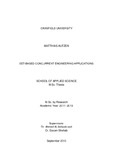JavaScript is disabled for your browser. Some features of this site may not work without it.
| dc.contributor.advisor | Al-Ashaab, Ahmed | |
| dc.contributor.advisor | Shehab, Essam | |
| dc.contributor.author | Autzen, Matthias | |
| dc.date.accessioned | 2014-05-08T13:50:52Z | |
| dc.date.available | 2014-05-08T13:50:52Z | |
| dc.date.issued | 2013-09 | |
| dc.identifier.uri | http://dspace.lib.cranfield.ac.uk/handle/1826/8434 | |
| dc.description.abstract | Engineering companies must improve their product development performance in order to meet the challenges of the 21st century where R&D activities are coming more and more under pressure of productivity demands. Lean thinking is an improvement philosophy, which focuses on the creation of customer-defined value and the elimination of waste. The application of lean techniques to manufacturing and production processes has helped western engineering companies to stay competitive against their counter-parts from low- wage countries in the last 20-30 years. However, compared to lean manufacturing, relatively little research has been conducted in the field of lean product and process development. Set-based concurrent engineering is advocated to be one key enabler for lean product and process development and seemed to be a promising approach to enhance product development projects with several potential benefits in relation to conventional approaches. This research project focuses on synthesizing the good practices of set-based concurrent engineering within the context of lean product development, formally embedding certain set-based methodologies into an existing product development process of a company whilst defining a step-by-step guideline how to do it. Finally the new transformed development process model shall be applied in a case study in order to evaluate its practical applicability as well as the advantages and disadvantages. After synthesising the good practices of lean product development and set- based concurrent engineering through an extensive literature review a field study in the collaborating company has been conducted. With the help of a developed questionnaire the current practices have been analysed against the SBCE principles with the goal to identify the challenges and opportunities for improvements. Considering the results of the field study a new transformed set- based product development model has been defined guided by a developed step-by-step transformation methodology. Finally the new transformed product development process model has been evaluated in a real industrial case study in order to give an assessment of the practical applicability as well as advantages and disadvantages of the SBCE approach. This research provides a practical approach of a step-by-step transformation methodology to support companies to integrate the SBCE good practices into their traditional PD model. The transformed product development process model contains several new aspects that enforce innovation and creativity as well as decreasing the risk of rework at later stages of the process. | en_UK |
| dc.language.iso | en | en_UK |
| dc.publisher | Cranfield University | en_UK |
| dc.rights | © Cranfield University 2013. All rights reserved. No part of this publication may be reproduced without the written permission of the copyright owner. | en_UK |
| dc.subject | Set-based concurrent engineering | en_UK |
| dc.subject | LeanPPD | en_UK |
| dc.subject | Product development | en_UK |
| dc.subject | Lean transformation | en_UK |
| dc.title | Set-based concurrent engineering applications | en_UK |
| dc.type | Thesis or dissertation | en_UK |
| dc.type.qualificationlevel | Masters | en_UK |
| dc.type.qualificationname | MSc by Research | en_UK |
